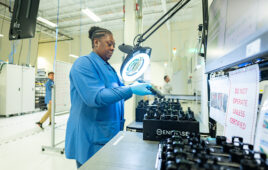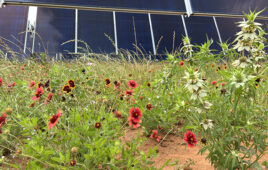The U.S. solar manufacturing industry, which today can supply fewer than 8 GW of assembled modules if each facility is pumping at full volume, could almost double within two years — if every company that claimed in 2021 it was starting a new factory follows through.
Fueling the Gold Rush-like dash to the module-thirsty U.S. region (with annual demand over 30 GW, the country is desperate for untariffed, domestic modules) is the Solar Energy Manufacturing for America (SEMA) Act, as included in the Build Back Better Act (BBB). Even though the Act has not yet passed, just the hint of manufacturing support led companies to announce their plans to make solar panels in the United States. The suggested federal legislation would provide tax credits to American manufacturers at every stage of the solar panel manufacturing supply chain, from production of polysilicon to solar cells to fully assembled solar modules.
Credits to manufacturers included in the current draft version of BBB:
- solar-grade polysilicon ($3/kg)
- PV wafers ($12/m2)
- thin-film and silicon PV cells (4¢/WDC)
- thin-film and silicon PV modules (7¢/WDC)
The credits would begin to phase down to 75% for product sold in 2027, 50% in 2028 and 25% in 2029, before disappearing completely thereafter. With savings like that, there’s no reason the domestic market won’t explode with manufacturing activity, probably even more than the list of “maybes” announced in 2021.
Established solar powerhouses last year revealed their loose plans to enter the U.S. manufacturing market: Maxeon is contemplating up to 3 GW of cell and panel assembly stateside, Meyer Burger chose Arizona for a 400-MW facility, and REC is considering 1 GW.
Then there are the new names: Philadelphia Solar (a module maker from Jordan) claims it’s shopping a site for 1 GW, newbie Ubiquity Solar plans to open a 350-MW solar cell facility in New York and NanoPV (an Asian company that makes 100-W a-Si thin-film modules) wants to open a plant in Georgia with an unknown capacity.
Watching what actually pans out over this next year will be interesting. Virtually unknown NanoPV said it only needs $36 million to start a plant in Georgia that will support 500 jobs. Maxeon, meanwhile, applied for a DOE loan to support its manufacturing plans and has repeated the goal of starting solar panel production in 2023.
Each of these announcements is likely dependent on the BBB Act passing with solar manufacturing credits intact. We’re still awaiting a final vote.
“The bipartisan support for the domestic production of solar infrastructure has encouraged us to contribute to the energy independence and sustainability of the country,” said Ardes Johnson, president of Meyer Burger Americas, when its plans were first announced in September 2021. “It is of vital importance for the U.S. to expand the domestic supply chain and break away from its heavy reliance on Asia. We are pleased to be able to contribute to this important goal and are ready to serve the rapidly increasing demand for clean energy.”
The tax credits would also give a boost to existing domestic manufacturers, leading to possible manufacturing capacity expansions. Minnesota and Florida-based panel assembler Heliene welcomes new players to the U.S. market to enhance domestic supply.
“We are all saying we need a local/regional supply chain; however, it will not happen unless investors can have a horizon clear enough to ensure there is a possible return on their investment, going from polysilicon, ingot, wafer, cell and module production,” said Martin Pochtaruk, CEO of Heliene. “A possible reimbursable tax credit would support a return on investment on existing and new manufacturing lines, as well as expanding up or down the solar value chain.”





Odd though that with no cell capacity in the US, we only recently passed the 2.5 GW cell import mark. This means that no matter how high the nameplate capacity, we only produced 2.5 GW of modules in the US. Either super low utilization or some of that capacity isn’t real.
Very true. Also there is a lot of First Solar’s thin-film panel capacity included in the 8 GW estimate, which doesn’t use the 2.5 GW silicon TRQ. And I didn’t even include Tesla’s “gigafactory” in Buffalo in the 8 GW estimate.
Since lots of people, throughout the world, will be moving in the next decade or two or three, like Bangladesh, wouldn’t it be wise to develop self reliant building systems that would include solar PV, residential automation, etc.
This could be the technological kernel of a Department of Sustainability…the US unofficial department of offense.
“Even though the Act has not yet passed, just the hint of manufacturing support led companies to announce their plans to make solar panels in the United States.”
The term “vertical integration” comes to mind. It has been said the supply chain for solar PV isn’t necessarily crystalline cells to build panels with, it is the silicon foundry needed to supply this amount of manufacturing. Perhaps it’s well past time to wait on the next Government program like BBB to come along. Perhaps it’s time to go all in, not only on the manufacturing line but the supply chain line and have a foundry for silicon that one can use not only for solar PV cells, but for supply chains to IC chip manufacturers in the U.S.. This country needs to work smarter not harder by making the supply chain a country, to country, to country process that stacks their costs on top of everything used in the supply chain. Right now, there’s only one solar PV company that’s going to manufacture solar PV using energy generated by solar PV for its manufacturing facilities. Any time one cuts out the middleman in the energy curve, you make your business more resistant to dips in the economy.
Don’t necessarily agree with Heliene’s Martin Pochtaruk, tax credits will not help in the overall cost of end product. What IS needed are these interested manufacturers to find a sustainable business model one can cultivate into an economy of scope instead of economies of scale.